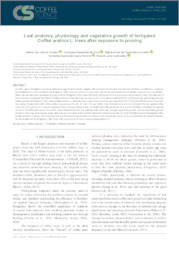Leaf anatomy, physiology and vegetative growth of fertigated Coffee arabica L. trees after exposure to pruning.
Leaf anatomy, physiology and vegetative growth of fertigated Coffee arabica L. trees after exposure to pruning.
Autoria: SOARES, D. dos S.; SILVA, E. A. da; CARVALHO, M. A. de F.; PEREIRA, F. A. C.; GUIMARÃES, R. J.
Resumo: In coffee plants, fertigation can be an alternative way to minimize the negative effects exerted by drought and maximize fertilizer use efficiency. However, the fertilization recommendations for fertigated coffee trees are still not very specific, and the recommendations for rainfed crops are used. In addition, little is known about the nutritional requirements for fertigated coffee trees that have undergone the low recepa pruning treatment. Thus, the objective of this study was to evaluate the effects of different levels of nitrogen (N), phosphorus (P), and potassium (K) fertilizers on leaf anatomy, physiology, and vegetative growth of fertigated coffee trees (Coffea arabica L.) that have been under the low recepa pruning treatment. During the first five years of growth, the cultivar Topázio MG-1190 of the coffee crop received 10, 40, 70, 100, 130, and 160% of the fertilization levels recommended for the rainfed coffee crop. After this period, the crop was exposed to low recepa pruning. It was concluded that different doses of N, P, and K fertilizers modified the internal structure of coffee plant leaves, as well as physiological responses and plant growth; there was stronger vegetative growth, sharper leaf blade, greater thickness of spongy parenchyma, larger phloem area, and higher xylem relative hydraulic conductivity as the N, P, and K fertilizer levels in fertigated coffee (Coffea arabica L.) plants, which received the low recepa pruning treatment, increased. This knowledge can be used as a solid basis for main fertilization recommendations for fertigated coffee trees after exposure to the low recepa pruning treatment.
Ano de publicação: 2021
Tipo de publicação: Artigo de periódico
Unidade: Embrapa Café
Palavras-chave: Anatomia Vegetal, Coffea Arábica, Fertigation, Fertilizante, Mineral fertilizers, Nutriente Mineral, Poda, Pruning
Observações
1 - Por padrão são exibidas publicações dos últimos 20 anos. Para encontrar publicações mais antigas, configure o filtro ano de publicação, colocando o ano a partir do qual você deseja encontrar publicações. O filtro está na coluna da esquerda na busca acima.
2 - Para ler algumas publicações da Embrapa (apenas as que estão em formato ePub), é necessário ter, no celular ou computador, um desses softwares gratuitos. Sistemas Android: Google Play Livros; IOS: iBooks; Windows e Linux: software Calibre.
Acesse outras publicações
Acesse a Base de Dados da Pesquisa Agropecuária (BDPA) para consultar o acervo completo das bibliotecas da Embrapa.

